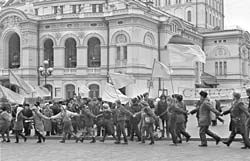Union Day: not a symbol of the past but a signal from the future

Last Friday Ukraine officially observed a holiday that should (or should have?) become a sacred symbol of the unity of our political nation from Donetsk to Uzhhorod, from Chernihiv to Symferopol. This was Union Day, which will always be a reminder to contemporaries and their descendants of Jan. 22, 1919, when Kyiv’s St. Sophia Square heard the solemn proclamation of an historic act of the official union of the Ukrainian National Republic and the Western Ukrainian National Republic (ZUNR). The initiators of this act joining the Ukrainians of Halychyna with their brethren in eastern Ukraine — Symon Petliura, Volodymyr Vynnychenko, and Yevhen Petrushevych (president of the ZUNR) — firmly believed that from then on and for centuries to come the once separated branches of the Ukrainian people would be politically and spiritually united.
The path to the realization of this noble dream was a terrible and tragic one. Two weeks later, on Feb. 5, 1919, Kyiv was captured by Bolshevik troops, who understood the unity of Ukraine as a purely nationalistic slogan and did their best to drown the national spirit in blood. Yet even today the long dreamed-of goal of One Indivisible Ukraine has still not been attained in many respects. (We must admit this honestly and frankly because illusions, no matter how “rosy” they may be, lead to a dead end.) Why?
To answer this question, it is necessary to determine why the Ukrainian national revolution of 1918-1922 failed. In spite of different views, most historians agree that the fatal role in the Ukrainian liberation movement was played by disunity, a maniacal aspiration of politicians to fight not so much against real enemies (primarily, foreign ones) as among themselves for the coveted “mace,” the symbol of power, and also by their inability to wisely and harmoniously resolve ethnic and social problems, which are the Scylla and Charybdis through which all revolutions must pass. There were also tragic disagreements between the leaders of the ZUNR (mostly liberals and conservatives) and the socialist- minded leaders of the Ukrainian National Republic.
Dear reader, does this remind you in some way of contemporary developments? The answer is all too obvious. For us Union Day is not a symbol of the past but a tragic signal from the future that is warning us about what can destroy the Ukrainian state. Moreover, it is a very pressing problem to find the principles that could unite western and eastern Ukrainians. (We must admit that here things have not improved much, to put it mildly, during the year in which the Orange government has been in power.)
I will briefly mention these principles: equality before the law for absolutely all individuals no matter where they reside, whether in Donetsk or Lviv, and no matter what offices they hold (Immanuel Kant said that one should not deliver long speeches about moral politics but should just strictly obey the law); the refusal to make lofty promises and express agreeable but empty words (it is better to do something without superfluous words); responsibility on the part of the topmost official all the way to a humble housing maintenance employee; rejection of the practice whereby a narrow circle of individuals close to “the No. 1 person” makes all the decisions. The final principle is a clear understanding on the part of all government branches that people vest them with power not forever but for a certain period of time, and the people will inevitably proclaim a just verdict (for this is democracy). At the same time every rank and file citizen must clearly understand: quite a lot (as a minimum) depends on me in our (not “this”) country, because my children, grandchildren, and I have to live here. In my opinion, these are the principles that could bring together the Ukrainian political nation. Readers can probably name quite a few others. This is the beginning of a very pressing and crucial dialogue.






